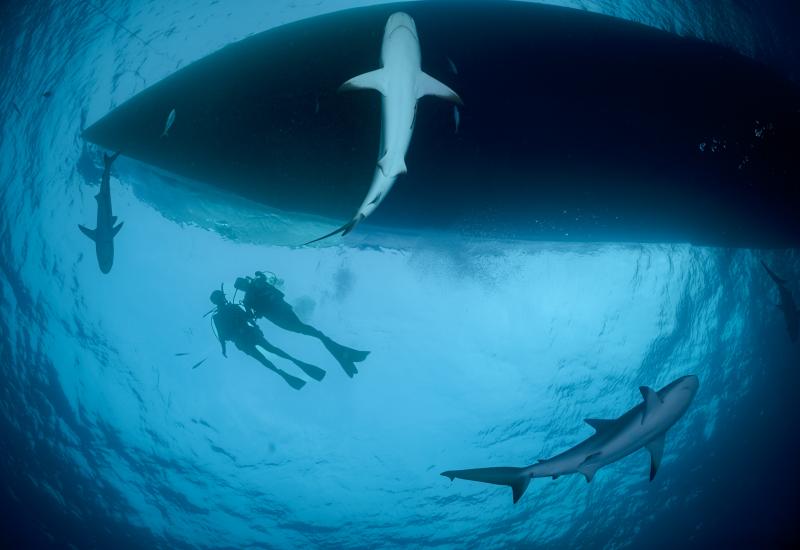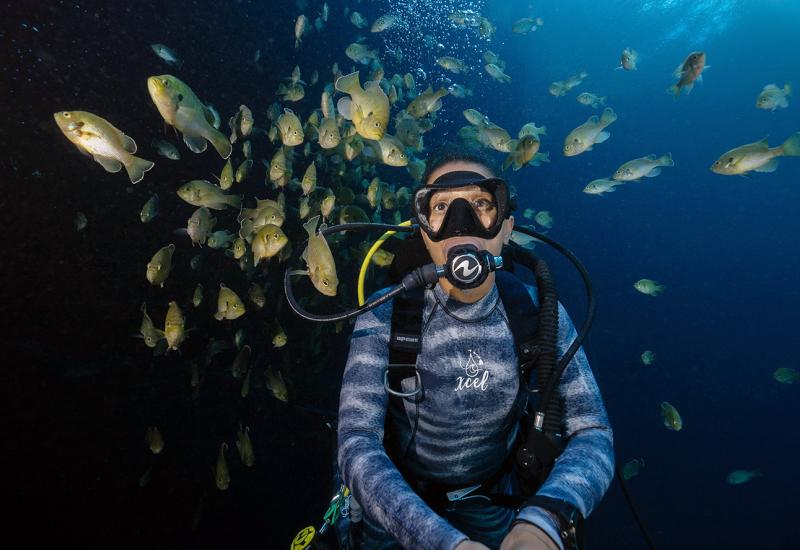10 New Dive Computers
SCUBALAB TESTS 10 NEW DIVE COMPUTERS
By Bill Kendig
Photography by Joseph Byrd
| Scuba Lab 10 New Dive Computers Chamber Test--(788K PDF) |

Like their desktop cousins, dive computers evolve at what seems like light speed. The minute we finish testing the latest batch, new models arrive on the scene promising more features and new options. Fortunately, just as DOS gave way to Windows, dive computers have also gotten easier to read, understand and use for their intended purpose--to provide the information you need to dive the way you want. The 10 new computers reviewed in this article continue the trend and are among the most capable and user-friendly models we've tested yet.
How We Tested Them
We invited all major manufacturers to submit their new computer models for evaluation and received six wristwatch computers, three wrist-mount computers and one console computer. After reading the spec sheets, owner's manuals and manufacturers' web sites, we tested each one to make sure it was in working order. We then assigned the computers to a team of six highly experienced recreational divers. Over a period of approximately two months of ergonomic testing, these divers served as your stand-ins, becoming intimately familiar with the computers and using them in the course of their normal diving routines. After each dive, they rated each computer on seven different categories of performance (see Ergonomic Performance chart), and made notes and comments on how "diver-friendly" each computer was. Between dives, they checked to see how well the computers displayed surface interval time, and how easy it was to access logbook information.
For the final phase of testing, the computers were taken to the USC Catalina Hyperbaric Chamber and subjected to a four-dive profile to see if their algorithms trended either liberal (more bottom time) or conservative (less bottom time). With all tests complete, we gathered the scores and notes, and compiled the following reviews.
Wristwatch Computers
||||||
|---|---|---|---|---|
|

|

|
|Aeris: Manta| Oceanic: Geo|
Aeris Manta / Oceanic Geo
Rugged, light and priced right, these identical watch-style computers are nitrox-capable up to 50 percent. Press one button and you are into air, nitrox, gauge or free dive mode. Don't worry if you forget, they automatically activate when you hit the water. Test divers found the main screen easy to read with just the most important info offered (depth, no-decompression limit, bottom time and nitrogen loading bar graph) while alternate screens fill in the rest of the details. Compare them side-by-side and you'll find the Aeris Manta has slightly bolder digits than the Oceanic Geo, but test divers found both displays "very clear and easy to read." After a dive, the Manta and Geo display surface time for 10 minutes before going back to watch mode.
Liberal or Conservative: Liberal. The Aeris Manta and Oceanic Geo both use a modified Haldanean algorithm that doesn't restrict your bottom time. Both have a Conservative Factor option, allowing you to reduce your no-decompression limits to that of the next 3,000-foot altitude setting.
Owner's Manual: The manuals are exceptional, earning praise from test divers for ease of use and understanding. The books carefully walk you through every step and setting with screen shots to help you picture what you should be seeing. They also come with a laminated reference card to answer those questions that come up only after you're dripping wet.
Bottom Line: For an entry-level computer or use as a backup gauge, you can't do any better than these two compact instruments. They are easy to operate, easy to read, and easy on the pocket with the lowest retail price of those tested: $429.95.
||||||
|---|---|---|---|---|
|

|

|
|Aeris: Epic| Oceanic: Atom 2.0|
Aeris Epic / Oceanic Atom 2.0
If you enjoy a casual recreational dive one day and a multi-gas tech dive the next, then the Aeris Epic and Oceanic Atom 2.0 are for you. Both are wireless, air-integrated computers that can track three different nitrox mixes (up to 100 percent oxygen) using three different transmitters. Features and functions are the same--including the unique Buddy Pressure Check function that allows you to keep tabs on the tank pressure of up to two other divers-- with only minor cosmetic differences in some of the icons the computers use to display information. A new mineral-glass lens and an uncluttered layout make the main screen very easy to read, and both have an intuitive system for scrolling through alternate screens to track additional information and tap into the advanced features. The nitrogen-loading bar graph is easy to understand and the variable ascent-rate monitor helps you maintain precise control with text warnings ("Slow" and "Too Fast") when you are exceeding the speed limit.
Liberal or Conservative: Liberal. You can use the Conservative Factor Adjustment to cut into bottom-time calculations if you like, or set the nitrogen-loading bar graph alarm to alert you when you reach a pre-determined level.
Owner's Manual: Test divers rated the owner's manuals as excellent, and found the step-by-step instructions with screen shots among the easiest to understand. They also come with a laminated prompt card for quick reference in the field.
Bottom Line: Air/nitrox computers don't get much more feature-rich than the Aeris Epic and the Oceanic Atom 2.0, and squeezing this much computing power into a sharp wristwatch package that's still easy to read is an impressive feat. Price: $669.95 for the computer; $949.95 complete with one transmitter, PC download kit and other accessories.
||||
|---|---|---|
|

|
|Cressi-sub: EDY|
Cressi-sub EDY
The EDY is a single-gas computer capable of handling nitrox mixes up to 50 percent, and it uses color-coded bar graphs to help divers monitor ascent rate, nitrogen loading and oxygen loading. Test divers also found the display digits and other screen graphics among the easiest-to-read in the wristwatch-style category, rating the main screen display (depth, no-decompression limit, bottom time and max depth) very good for ease of reading and understanding. "The digits are as large as those on some regular-sized computers," commented one diver. Alternate data screens are easy to access, and the backlight was one of the brightest in the test group. The battery has an average life of two years and should be returned to an authorized center for replacement.
Liberal or Conservative: The EDY, programmed with the Buhlmann ZH-L12 algorithm, was one of the most conservative computers we tested. You can make the EDY even more conservative with three Safety Factor settings.
Owner's Manual: Navigating the owner's manual is an awkward task. A pull-out chart of screen shots found at the back of the book is helpful, but test divers said they would have preferred step-by-step instructions with corresponding illustrations on the same page.
Bottom Line: The Cressi-sub EDY is not just another pretty face. It offers one of the best displays, using color-coded bar graphs and large bold numbers--features usually found only on larger gauges. Price: $590.
||||
|---|---|---|
|

|
|Mares: Nemo Sport|
Mares Nemo Sport
Topside, the new Nemo Sport computer from Mares is a rugged digital timepiece set in a thermoplastic housing. Take it below water and it's a full-function recreational dive computer that can be set for air or nitrox mixes up to 99 percent. Test divers found the display very easy to read with only the most important info displayed (depth, no-decompression limits, bottom time), and a bright backlight that helps in low-light conditions. Our divers also like the placement and function of the ascent rate and nitrogen-loading bar graphs.
Liberal or Conservative » The Nemo Sport uses the new Mares RGBM Sport Algorithm with Deep Stop capability. This new software made it one of the most conservative models tested. You can also make it even more conservative with the User Safety Factor.
Owner's Manual: The owner's manual received lukewarm scores due to small print and less-than-intuitive charts. Screen shots throughout do help, and test divers said setup and navigation became easier the more they used the manual.
Bottom Line: This is an excellent choice if you want a simple, single-gas computer at a very competitive retail price--$450, the second-lowest in this review.
Full-sized Wrist Computers
||||||
|---|---|---|---|---|
|

|

|
|Aeris: Elite T3| Oceanic: VT3|
Aeris Elite T3 / Oceanic VT3
If you want a computer that does it all with the easy readability of a full-sized gauge, there are only two choices in this test group, the Aeris Elite T3 and the Oceanic VT3. Both are wireless, air-integrated computers that can track three different gas mixes (up to 100 percent oxygen) using three different transmitters. They also feature the clever Buddy Pressure Check function that allows you to keep tabs on the tank pressures of up to two other divers. Compared to wristwatch-style machines, the digits are bigger, the bar graphs bolder and everything you need to know is displayed on the main screen, earning both these computers the highest overall scores for readability. "The screens are super easy to read and so intuitive," said one test diver. While the Aeris Elite T3 and Oceanic VT3 offer all the same functions, there is some sibling rivalry in how they choose to display their information--particularly when it comes to bar graphs for ascent rate, nitrogen loading and oxygen loading. Compare the computers side-by-side, and you'll see that the Aeris Elite T3 uses larger, bolder segments in the bar graphs and a color-coded scale, earning this feature the highest numeric rating from test divers. The Oceanic VT3 is no slouch, however. It's more elegant and understated bar graph presentation is still easy to read and earned the second-highest rating from test divers.
Liberal or Conservative: Liberal. A Conservative Factor setting can be used to decrease no-decompression limits, and there is an adjustable Safety Stop setting that allows you to program the time and depth for custom stops.
Owner's Manual: The owner's manuals received the highest scores available for ease of use and understanding. The easy-to-follow directions guide the user through operational modes and settings, and screen shots are pictured throughout for clear illustration. A laminated reference card is also included.
Bottom Line: These are two of the most feature-rich computers on the market today and thanks to the full-sized gauge face, uncluttered layouts and intuitive alternate screen options, they are easy to use and read whether set for simple air dives or configured for multi-gas/multi-transmitter dives. Price: $639.95 for the computer; $949.95 complete with one transmitter, PC download kit and other accessories.
||||
|---|---|---|
|

|
|Mares: Nemo Wide|
Mares Nemo Wide
Test divers found the Nemo Wide to be the all-around easiest wrist computer to read, thanks to the largest screen in this test group. Add to that the Mattel-sized buttons that can be pressed with even the thickest gloves and you understand the phrase "Go big or go home" as it relates to dive computers. The Nemo Wide is a basic air/nitrox computer (up to 50 percent) with gauge mode capability. Its strength lies in clear readability of the most pertinent data--depth, NDLs, temperature and bottom time are big and bold on the main screen. Test divers gave it the highest score for ease of discerning critical data at depth. The ascent rate indicator includes a bar graph and digital feet-per-minute readout that takes all the guesswork out of slow, safe ascents.
Liberal or Conservative: The Mares RGBM algorithm in the Nemo Wide made it the most conservative computer tested in this review. For even more conservative calculations, you can increase the safety factor with three personal settings.
Owner's Manual: The owner's manual is slightly harder to read than others reviewed, due mainly to small print. Large illustrations of screen shots help, as does the inherent simplicity of the computer.
Bottom Line: The wide screen, bold digits and uncluttered display makes this one of the easiest computers to read, and in the water it's no more bulky than any wrist-mount computer. Price: $550.
Console Computers
||||
|---|---|---|
|

|
|Sherwood Scuba: Wisdom 2|
Sherwood Scuba Wisdom 2
Test divers found a lot to like about this updated version of Sherwood Scuba's popular air-integrated console computer, starting with the large screen, easy-to-read digits and simple navigation menus. All the important data is on the main screen, and air pressure stands out with the biggest digits of any computer tested in this review. The Wisdom 2 is a single-gas computer with nitrox capability up to 50 percent oxygen, and a gauge mode. Easy-to-read bar graphs present nitrogen tissue loading, oxygen loading and ascent rate information along the perimeter, with caution zones highlighted in yellow. The integrated console design means there are never any "linking" issues with transmitters. It can also accept a compact compass for a slim, off-the-wrist instrument panel, and an optional quick-disconnect fitting lets you take the computer with you between dives. As with other air-integrated computers, the Wisdom 2 offers a number of user-controlled alarm settings that warn you when you're low on air, reaching no-deco limits, exceeding ascent rates or approaching oxygen thresholds.
Liberal or Conservative: Liberal. While there are no personal safety factor settings, the nitrogen-loading bar graph makes it easy to monitor and manage your exposure throughout the dive.
Owner's Manual: With step-by-step instructions written in plain English and great illustrations, the Wisdom 2 owner's manual earned the highest possible score from our test divers.
Bottom Line: The Wisdom 2 is an easy-to-use console computer that delivers everything you need to know with a clear and intuitive design. Price: $800; $870 with compass; $855 with quick-disconnect; $890 with both.
Dive Computer Features
Dive Computer Features cont.
Ergonomic Performance
Ergonomic Performance cont.
Still Looking for the Right Computer?

Here is a summary of the computers reviewed in 2006. For full details, see the gear section of www.scubadiving.com.
Wristwatch-Style
Suunto D6 A conservative, two-gas, air/nitrox computer capable of handling mixes up to 99 percent, the D6 makes good use of bold numbers, icons and color bar graphs to display lots of data on a small screen. It also offers an integrated digital compass.
Full-Sized Wrist-Mount-Style
Beuchat Voyager A liberal, single-gas air/nitrox dive computer capable of handling nitrox mixes up to 50 percent. It's easy to read thanks to large digits for both critical and noncritical data.
Cressi-sub Archimedes 2 A conservative two-gas computer compatible with nitrox mixes up to 99 percent. Test divers liked the big screen, big data digits and four-color bar graphs.
Mares M2 RGBM A user-friendly, single-gas, air/nitrox computer at a very reasonable price. Powered by user-replaceable AAA batteries, the M2 is capable of handling nitrox mixes to 50 percent.
Sherwood Scuba Insight This is a liberal single-gas air/nitrox computer (mixes up to 50 percent) with uncluttered displays, effective three-color bar graphs and an excellent owner's manual.
Uwatec Smart Z Complete A hoseless, air-integrated computer loaded with features, including microbubble suppression technology. It's a single-gas computer capable of handling nitrox mixes up to 100 percent.
Uwatec Aladin TEC 2G This computer can juggle two nitrox mixes from 21 to 100 percent oxygen. The display uses a green/yellow/red-coded nitrogen-loading bar graph and large, easy-to-read numbers. It also uses microbubble suppression technology.
Suunto Vytec DS Upgraded to incorporate Suunto's RGBM Deep Stop Algorithm, the Vytec DS lets you switch between three gas mixes (from 21 to 99 percent oxygen) and offers the option of wireless air integration.
SCUBALAB TESTS 10 NEW DIVE COMPUTERS
Photography by Joseph Byrd
| Scuba Lab 10 New Dive Computers Chamber Test--(788K PDF)|
Like their desktop cousins, dive computers evolve at what seems like light speed. The minute we finish testing the latest batch, new models arrive on the scene promising more features and new options. Fortunately, just as DOS gave way to Windows, dive computers have also gotten easier to read, understand and use for their intended purpose--to provide the information you need to dive the way you want. The 10 new computers reviewed in this article continue the trend and are among the most capable and user-friendly models we've tested yet.

How We Tested Them
We invited all major manufacturers to submit their new computer models for evaluation and received six wristwatch computers, three wrist-mount computers and one console computer. After reading the spec sheets, owner's manuals and manufacturers' web sites, we tested each one to make sure it was in working order. We then assigned the computers to a team of six highly experienced recreational divers. Over a period of approximately two months of ergonomic testing, these divers served as your stand-ins, becoming intimately familiar with the computers and using them in the course of their normal diving routines. After each dive, they rated each computer on seven different categories of performance (see Ergonomic Performance chart), and made notes and comments on how "diver-friendly" each computer was. Between dives, they checked to see how well the computers displayed surface interval time, and how easy it was to access logbook information.
For the final phase of testing, the computers were taken to the USC Catalina Hyperbaric Chamber and subjected to a four-dive profile to see if their algorithms trended either liberal (more bottom time) or conservative (less bottom time). With all tests complete, we gathered the scores and notes, and compiled the following reviews.

Wristwatch Computers
|Aeris: Manta| Oceanic: Geo| Aeris Manta / Oceanic Geo
Rugged, light and priced right, these identical watch-style computers are nitrox-capable up to 50 percent. Press one button and you are into air, nitrox, gauge or free dive mode. Don't worry if you forget, they automatically activate when you hit the water. Test divers found the main screen easy to read with just the most important info offered (depth, no-decompression limit, bottom time and nitrogen loading bar graph) while alternate screens fill in the rest of the details. Compare them side-by-side and you'll find the Aeris Manta has slightly bolder digits than the Oceanic Geo, but test divers found both displays "very clear and easy to read." After a dive, the Manta and Geo display surface time for 10 minutes before going back to watch mode.

Liberal or Conservative: Liberal. The Aeris Manta and Oceanic Geo both use a modified Haldanean algorithm that doesn't restrict your bottom time. Both have a Conservative Factor option, allowing you to reduce your no-decompression limits to that of the next 3,000-foot altitude setting.
Owner's Manual: The manuals are exceptional, earning praise from test divers for ease of use and understanding. The books carefully walk you through every step and setting with screen shots to help you picture what you should be seeing. They also come with a laminated reference card to answer those questions that come up only after you're dripping wet.
Bottom Line: For an entry-level computer or use as a backup gauge, you can't do any better than these two compact instruments. They are easy to operate, easy to read, and easy on the pocket with the lowest retail price of those tested: $429.95.Liberal or Conservative: Liberal. The Aeris Manta and Oceanic Geo both use a modified Haldanean algorithm that doesn't restrict your bottom time. Both have a Conservative Factor option, allowing you to reduce your no-decompression limits to that of the next 3,000-foot altitude setting.
Owner's Manual: The manuals are exceptional, earning praise from test divers for ease of use and understanding. The books carefully walk you through every step and setting with screen shots to help you picture what you should be seeing. They also come with a laminated reference card to answer those questions that come up only after you're dripping wet.
Bottom Line: For an entry-level computer or use as a backup gauge, you can't do any better than these two compact instruments. They are easy to operate, easy to read, and easy on the pocket with the lowest retail price of those tested: $429.95.

|Aeris: Epic| Oceanic: Atom 2.0| Aeris Epic / Oceanic Atom 2.0
If you enjoy a casual recreational dive one day and a multi-gas tech dive the next, then the Aeris Epic and Oceanic Atom 2.0 are for you. Both are wireless, air-integrated computers that can track three different nitrox mixes (up to 100 percent oxygen) using three different transmitters. Features and functions are the same--including the unique Buddy Pressure Check function that allows you to keep tabs on the tank pressure of up to two other divers-- with only minor cosmetic differences in some of the icons the computers use to display information. A new mineral-glass lens and an uncluttered layout make the main screen very easy to read, and both have an intuitive system for scrolling through alternate screens to track additional information and tap into the advanced features. The nitrogen-loading bar graph is easy to understand and the variable ascent-rate monitor helps you maintain precise control with text warnings ("Slow" and "Too Fast") when you are exceeding the speed limit.
Liberal or Conservative: Liberal. You can use the Conservative Factor Adjustment to cut into bottom-time calculations if you like, or set the nitrogen-loading bar graph alarm to alert you when you reach a pre-determined level.
Owner's Manual: Test divers rated the owner's manuals as excellent, and found the step-by-step instructions with screen shots among the easiest to understand. They also come with a laminated prompt card for quick reference in the field.
Bottom Line: Air/nitrox computers don't get much more feature-rich than the Aeris Epic and the Oceanic Atom 2.0, and squeezing this much computing power into a sharp wristwatch package that's still easy to read is an impressive feat. Price: $669.95 for the computer; $949.95 complete with one transmitter, PC download kit and other accessories.

|Cressi-sub: EDY| Cressi-sub EDY
The EDY is a single-gas computer capable of handling nitrox mixes up to 50 percent, and it uses color-coded bar graphs to help divers monitor ascent rate, nitrogen loading and oxygen loading. Test divers also found the display digits and other screen graphics among the easiest-to-read in the wristwatch-style category, rating the main screen display (depth, no-decompression limit, bottom time and max depth) very good for ease of reading and understanding. "The digits are as large as those on some regular-sized computers," commented one diver. Alternate data screens are easy to access, and the backlight was one of the brightest in the test group. The battery has an average life of two years and should be returned to an authorized center for replacement.
Liberal or Conservative: The EDY, programmed with the Buhlmann ZH-L12 algorithm, was one of the most conservative computers we tested. You can make the EDY even more conservative with three Safety Factor settings.
Owner's Manual: Navigating the owner's manual is an awkward task. A pull-out chart of screen shots found at the back of the book is helpful, but test divers said they would have preferred step-by-step instructions with corresponding illustrations on the same page.
Bottom Line: The Cressi-sub EDY is not just another pretty face. It offers one of the best displays, using color-coded bar graphs and large bold numbers--features usually found only on larger gauges. Price: $590.

|Mares: Nemo Sport| Mares Nemo Sport
Topside, the new Nemo Sport computer from Mares is a rugged digital timepiece set in a thermoplastic housing. Take it below water and it's a full-function recreational dive computer that can be set for air or nitrox mixes up to 99 percent. Test divers found the display very easy to read with only the most important info displayed (depth, no-decompression limits, bottom time), and a bright backlight that helps in low-light conditions. Our divers also like the placement and function of the ascent rate and nitrogen-loading bar graphs.
Liberal or Conservative » The Nemo Sport uses the new Mares RGBM Sport Algorithm with Deep Stop capability. This new software made it one of the most conservative models tested. You can also make it even more conservative with the User Safety Factor.
Owner's Manual: The owner's manual received lukewarm scores due to small print and less-than-intuitive charts. Screen shots throughout do help, and test divers said setup and navigation became easier the more they used the manual.
Bottom Line: This is an excellent choice if you want a simple, single-gas computer at a very competitive retail price--$450, the second-lowest in this review.

Full-sized Wrist Computers
|Aeris: Elite T3| Oceanic: VT3| Aeris Elite T3 / Oceanic VT3
If you want a computer that does it all with the easy readability of a full-sized gauge, there are only two choices in this test group, the Aeris Elite T3 and the Oceanic VT3. Both are wireless, air-integrated computers that can track three different gas mixes (up to 100 percent oxygen) using three different transmitters. They also feature the clever Buddy Pressure Check function that allows you to keep tabs on the tank pressures of up to two other divers. Compared to wristwatch-style machines, the digits are bigger, the bar graphs bolder and everything you need to know is displayed on the main screen, earning both these computers the highest overall scores for readability. "The screens are super easy to read and so intuitive," said one test diver. While the Aeris Elite T3 and Oceanic VT3 offer all the same functions, there is some sibling rivalry in how they choose to display their information--particularly when it comes to bar graphs for ascent rate, nitrogen loading and oxygen loading. Compare the computers side-by-side, and you'll see that the Aeris Elite T3 uses larger, bolder segments in the bar graphs and a color-coded scale, earning this feature the highest numeric rating from test divers. The Oceanic VT3 is no slouch, however. It's more elegant and understated bar graph presentation is still easy to read and earned the second-highest rating from test divers.
Liberal or Conservative: Liberal. A Conservative Factor setting can be used to decrease no-decompression limits, and there is an adjustable Safety Stop setting that allows you to program the time and depth for custom stops.
Owner's Manual: The owner's manuals received the highest scores available for ease of use and understanding. The easy-to-follow directions guide the user through operational modes and settings, and screen shots are pictured throughout for clear illustration. A laminated reference card is also included.

Bottom Line: These are two of the most feature-rich computers on the market today and thanks to the full-sized gauge face, uncluttered layouts and intuitive alternate screen options, they are easy to use and read whether set for simple air dives or configured for multi-gas/multi-transmitter dives. Price: $639.95 for the computer; $949.95 complete with one transmitter, PC download kit and other accessories.

|Mares: Nemo Wide| Mares Nemo Wide
Test divers found the Nemo Wide to be the all-around easiest wrist computer to read, thanks to the largest screen in this test group. Add to that the Mattel-sized buttons that can be pressed with even the thickest gloves and you understand the phrase "Go big or go home" as it relates to dive computers. The Nemo Wide is a basic air/nitrox computer (up to 50 percent) with gauge mode capability. Its strength lies in clear readability of the most pertinent data--depth, NDLs, temperature and bottom time are big and bold on the main screen. Test divers gave it the highest score for ease of discerning critical data at depth. The ascent rate indicator includes a bar graph and digital feet-per-minute readout that takes all the guesswork out of slow, safe ascents.
Liberal or Conservative: The Mares RGBM algorithm in the Nemo Wide made it the most conservative computer tested in this review. For even more conservative calculations, you can increase the safety factor with three personal settings.
Owner's Manual: The owner's manual is slightly harder to read than others reviewed, due mainly to small print. Large illustrations of screen shots help, as does the inherent simplicity of the computer.
Bottom Line: The wide screen, bold digits and uncluttered display makes this one of the easiest computers to read, and in the water it's no more bulky than any wrist-mount computer. Price: $550.
Console Computers

|Sherwood Scuba: Wisdom 2| Sherwood Scuba Wisdom 2
Test divers found a lot to like about this updated version of Sherwood Scuba's popular air-integrated console computer, starting with the large screen, easy-to-read digits and simple navigation menus. All the important data is on the main screen, and air pressure stands out with the biggest digits of any computer tested in this review. The Wisdom 2 is a single-gas computer with nitrox capability up to 50 percent oxygen, and a gauge mode. Easy-to-read bar graphs present nitrogen tissue loading, oxygen loading and ascent rate information along the perimeter, with caution zones highlighted in yellow. The integrated console design means there are never any "linking" issues with transmitters. It can also accept a compact compass for a slim, off-the-wrist instrument panel, and an optional quick-disconnect fitting lets you take the computer with you between dives. As with other air-integrated computers, the Wisdom 2 offers a number of user-controlled alarm settings that warn you when you're low on air, reaching no-deco limits, exceeding ascent rates or approaching oxygen thresholds.
Liberal or Conservative: Liberal. While there are no personal safety factor settings, the nitrogen-loading bar graph makes it easy to monitor and manage your exposure throughout the dive.
Owner's Manual: With step-by-step instructions written in plain English and great illustrations, the Wisdom 2 owner's manual earned the highest possible score from our test divers.
Bottom Line: The Wisdom 2 is an easy-to-use console computer that delivers everything you need to know with a clear and intuitive design. Price: $800; $870 with compass; $855 with quick-disconnect; $890 with both.
Dive Computer Features


|

|

|

| |Price| $429.95| $429.95| $949.95 Complete| $949.95 Complete| $590| |Made In| USA| USA| USA| USA| Japan| |Warranty| 2-yr. ltd.| 2-yr. ltd.| 2-yr. ltd.| 2-yr. ltd.| 1 year| |Algorithm (Tissue Compartments)| Modified Haldanean (12 TCs)| Modified Haldanean (12 TCs)| Modified Haldanean (12 TCs)| Modified Haldanean (12 TCs)| Buhlmann ZH-L12 (12 TCs)| |Air-Integrated| No| No| Yes| Yes| No| |Battery| 3V Lithium User- Replaceable| 3V Lithium User- Replaceable| 3V Lithium User- Replaceable| 3V Lithium User- Replaceable| 3V Lithium Mfg.- Replaceable| |Nitrox Percentage| 21-50| 21-50| 21-100| 21-100| 21-50| |Programmable Gas Mixes| 1| 1| 3| 3| 1| |PC Interface| Optional/$99| Optional/$99| Included| Included| Optional/ about$100| |Dive Plan/Simulator| Yes| Yes| Yes| Yes| Yes| |Graphic Displays| Yes| Yes| Yes| Yes| Yes| |Color Highlights| Yes| Yes| No| No| Yes| |Prompt Card| Yes| Yes| Yes| Yes| No| |Mounting Options| Wrist| Wrist| Wrist| Wrist| Wrist| |Activation| Water or Push-button| Water or Push-button| Water or Push-button| Water or Push-button| Water or Push-button| |User Controls| 4 buttons| 4 buttons| 4 buttons| 4 buttons| 4 buttons| |Programmable Safety Levels| Yes| Yes| Yes| Yes| Yes| |Logged Dives| 24| 24| 24| 24| 60 dives/30 hrs.| |Violation Lockout| 24 hrs.| 24 hrs.| 24 hrs.| 24 hrs.| 48 hrs.| |Alarms| Audible & Visual| Audible & Visual| Audible & Visual| Audible & Visual| Audible & Visual| |Gauge Mode| Yes| Yes| Yes| Yes| Yes| |Variable Ascent Rate| Yes| Yes| Yes| Yes| Yes| |Time To Fly| Countdown| Countdown| Countdown| Countdown| Calculated| |Max Deco Stop Ceiling| 60 ft.| 60 ft.| 60 ft.| 60 ft.| N/A| |Max Depth In Dive Mode| 330 ft.| 330 ft.| 330 ft.| 330 ft.| 325 ft.| |Illumination| 5 or 10 seconds| 5 or 10 seconds| 5 or 10 seconds| 5 or 10 seconds| 5 seconds| |Temp/Date/Time| Yes| Yes| Yes| Yes| Yes| |Max Altitude| 14,000 ft. auto.| 14,000 ft. auto.| 14,000 ft. auto.| 14,000 ft. auto.| 19,695 ft. auto.| |Lens Guard| No| No| Yes| Yes| No|
Dive Computer Features cont.
||||||| |---|---|---|---|---|---|
| | Wristwatch-Style| Console| Wrist-Mount| | |
|

|

|

|

| |Price| $450| $800| $949.95 Complete| $949.95 Complete| $550| |Made In| Japan| USA| USA| USA| Italy| |Warranty| 2-yr. ltd.| 2-yr. ltd.| 2-yr. ltd.| 2-yr. ltd.| 2-yr. ltd.| |Algorithm (Tissue Compartments)| Mares RGBM Sport (8 TCs)| Modified Haldanean (12 TCs)| Modified Haldanean (12 TCs)| Modified Haldanean (12 TCs)| Mares RGBM Sport (8 TCs)| |Air-Integrated| No| Yes| Yes| Yes| No| |Battery| 3V Lithium Dealer- Replaceable| 3V Lithium User- Replaceable| 3V Lithium User- Replaceable| 3V Lithium User- Replaceable| 3V Lithium User- Replaceable| |Nitrox Percentage| 21-99| 21-50| 21-100| 21-100| 21-50| |Programmable Gas Mixes| 1| 1| 3| 3| 1| |PC Interface| Optional/$150| Optional/$80| Included| Included| Optional/$120| |Dive Plan/Simulator| Yes| Yes| Yes| Yes| Yes| |Graphic Displays| Yes| Yes| Yes| Yes| Yes| |Color Highlights| Yes| Yes| Yes| Yes| No| |Prompt Card| No| No| Yes| Yes| No| |Mounting Options| Wrist| Console| Wrist, Retractor| Wrist, Retractor| Wrist| |Activation| Water or Push-button| Water or Push-button| Water or Push-button| Water or Push-button| Water or Push-button| |User Controls| 4 buttons| 2 buttons| 3 buttons| 3 buttons| 4 buttons| |Programmable Safety Levels| Yes| No| Yes| Yes| Yes| |Logged Dives| 30| 50| 24| 24| 38 hrs.| |Violation Lockout| 48 hrs.| 24 hrs.| 24 hrs.| 24 hrs.| 24 hrs.| |Alarms| Audible & Visual| Audible & Visual| Audible & Visual| Audible & Visual| Audible & Visual| |Gauge Mode| No| Yes| Yes| Yes| Yes| |Variable Ascent Rate| Yes| Yes| Yes| Yes| Yes| |Time To Fly| Countdown| Countdown| Countdown| Countdown| Calculated| |Max Deco Stop Ceiling| 79 ft.| 60 ft.| 60 ft.| 60 ft.| 79 ft.| |Max Depth In Dive Mode| 328 ft.| 330 ft.| 330 ft.| 330 ft.| 492 ft.| |Illumination| About 4 seconds| 10 seconds| 5 or 10 seconds| 5 or 10 seconds| About 8 seconds| |Temp/Date/Time| Yes| Yes| Yes| Yes| Yes| |Max Altitude| 18,000 ft. auto.| 14,000 ft. auto.| 14,000 ft. auto.| 14,000 ft. auto.| 12,139 ft. auto.| |Lens Guard| No| Yes| Yes| Yes| No|
Ergonomic Performance
||||||| |---|---|---|---|---|---|
| |
|

|

|

|

| |Ease Of Reading / Understanding Primary Screen| 4| 4| 4| 4| 4| |Ease Of Accessing Alt Screen Data| 4| 4| 4| 4| 3| |Ease Of Discerning Critical Data (Depth/NDLs/BT)| 4| 4| 4| 4| 4| |Ease Of Reading Warnings (N2 Bars, Ascent, Etc.)| 3| 3| 3| 3| 4| |Ease Of Discerning Noncritical Data (Temp, Time Of Day, Etc.)| 3| 3| 4| 4| 3| |Ease Of Activation / Effectiveness Of Backlight| 4| 4| 4| 4| 4| |Ease Of Accessing Surface Interval Data| 4| 4| 4| 4| 3| |Ease Of Using / Understanding Owner's Manual| 5| 5| 5| 5| 3| |5=Excellent 4=Very Good 3=Good 2=Fair 1=Poor|
Ergonomic Performance cont.

|

|

|

|

| |Ease Of Reading / Understanding Primary Screen| 4| 4| 5| 5| 5| |Ease Of Accessing Alt Screen Data| 3| 4| 4| 4| 4| |Ease Of Discerning Critical Data (Depth/NDLs/BT)| 4| 4| 4| 4| 5| |Ease Of Reading Warnings (N2 Bars, Ascent, Etc.)| 4| 4| 5| 4| 3| |Ease Of Discerning Noncritical Data (Temp, Time Of Day, Etc.)| 3| 4| 4| 4| 4| |Ease Of Activation / Effectiveness Of Backlight| 4| 4| 4| 4| 4| |Ease Of Accessing Surface Interval Data| 3| 4| 4| 4| 4| |Ease Of Using / Understanding Owner's Manual| 2| 5| 5| 5| 2| |5=Excellent 4=Very Good 3=Good 2=Fair 1=Poor|
Still Looking for the Right Computer?

Here is a summary of the computers reviewed in 2006. For full details, see the gear section of www.scubadiving.com.
Wristwatch-Style
Suunto D6 A conservative, two-gas, air/nitrox computer capable of handling mixes up to 99 percent, the D6 makes good use of bold numbers, icons and color bar graphs to display lots of data on a small screen. It also offers an integrated digital compass.
Full-Sized Wrist-Mount-Style
Beuchat Voyager A liberal, single-gas air/nitrox dive computer capable of handling nitrox mixes up to 50 percent. It's easy to read thanks to large digits for both critical and noncritical data.
Cressi-sub Archimedes 2 A conservative two-gas computer compatible with nitrox mixes up to 99 percent. Test divers liked the big screen, big data digits and four-color bar graphs.
Mares M2 RGBM A user-friendly, single-gas, air/nitrox computer at a very reasonable price. Powered by user-replaceable AAA batteries, the M2 is capable of handling nitrox mixes to 50 percent.
Sherwood Scuba Insight This is a liberal single-gas air/nitrox computer (mixes up to 50 percent) with uncluttered displays, effective three-color bar graphs and an excellent owner's manual.
Uwatec Smart Z Complete A hoseless, air-integrated computer loaded with features, including microbubble suppression technology. It's a single-gas computer capable of handling nitrox mixes up to 100 percent.
Uwatec Aladin TEC 2G This computer can juggle two nitrox mixes from 21 to 100 percent oxygen. The display uses a green/yellow/red-coded nitrogen-loading bar graph and large, easy-to-read numbers. It also uses microbubble suppression technology.
Suunto Vytec DS Upgraded to incorporate Suunto's RGBM Deep Stop Algorithm, the Vytec DS lets you switch between three gas mixes (from 21 to 99 percent oxygen) and offers the option of wireless air integration.




















